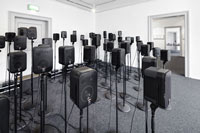Via Lew-
andowsky
»Anstimmen«
Via Lewandowsky has staged an 80-channel sound-installation in the exhibition. The starting point for his work was a recording of the so-called standard or concert pitch A used as tuning pitch by the 80 singers and musicians of the Latina August Hermann Francke Music Gymnasium in Halle. Playing together only becomes possible when all are attuned to the same note. This note, when transmitted from one singer to the others and imitated by them, strives to achieve the aural unity of all participants. This results in an acoustic pattern that exists only beyond the individual.
Music and the Brain
Neuroscientists don’t yet have the ultimate answers. But in recent years we have begun to gain a firmer understanding of where and how music is processed in the brain, which should lay a foun-dation for answering evolutionary questions. Collectively, studies of patients with brain injuries and imaging of healthy individuals have unexpectedly uncovered no specialized brain »center« for music. Rather, music engages many areas distributed throughout the brain, including those that are normally involved in other kinds of cognition. The active areas vary with the person’s individual experiences and musical training. The ear has the fewest sensory cells of any sensory organ – 3,500 inner hair cells occupy the ear versus 100 million photoreceptors in the eye. Yet our mental response to music is remarkably adaptable; even a little study can »retune« the way the brain handles musical inputs.
Little is known still about how music evokes emotional reactions. Pioneering work in 1991 by John A. Sloboda of Keele University in England revealed that more than 80 percent of sampled adults reported physical responses to music, including thrills, laughter or tears. Scientists recorded a heart rate, blood pressure, respiration and other physiological measures during the presentation of various pieces that were considered to express happiness, sadness, fear or tension. Each type of music elicited a different but con-sistent pattern of physiological change across subjects.
Another renowned study by Blood and Zatorre scanned the brains of musicians who had chills of euphoria when listening to music. They found that music activated some of the same reward systems that are stimulated by food, sex and addictive drugs.
Overall, findings to date indicate that music has a biological basis and that the brain has a functional organization for music. It seems fairly clear that many brain regions participate in specific aspects of music processing, whether supporting perception such as apprehending a melody, rhythms and tones or evoking emotion-al reactions. Musicians appear to have additional specializations, particularly hyperdevelopment of some brain structures. These effects demonstrate that learning retunes the brain, increasing both the responses of individual cells and the number of cells that react strongly to sounds that become important to an individual. As research on music and the brain continues, we can anticipate a greater understanding not only about music and its reasons for existence but also about how multifaceted it really is.
Text extracts from:
Norman M. Weinberger, Spektrum der Wissenschaft, 2005








